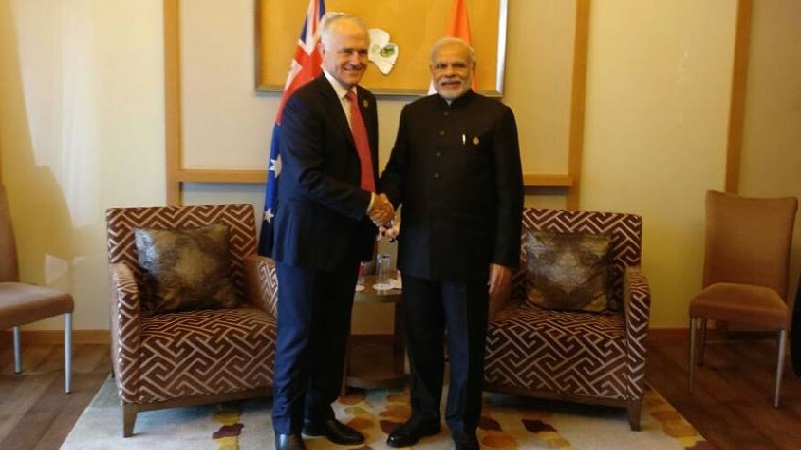Australia’s economic relationship with China and India: A snapshot
April 12 2017

Between 2011–2015, China and India accounted for an average of 35.5 percent and 11.9 percent of world GDP growth, respectively.[1]
In 2015-16 China was the number one customer for Australia’s goods worth $75.3 billion, accounting for 30.9 percent of total Australian goods exports. India bought $9.7 billion and ranked fifth, accounting for four percent of the total.[2]
In 2015-16, China was the number one customer for Australia’s services worth $10.7 billion, accounting for 15.6 percent of total Australian services exports. India bought $3.2 billion and ranked sixth, accounting for 4.7 percent of the total.[3]
Over the last five years Australia’s total goods and services exports to China increased by 21 percent. Australian exports to India decreased by 31 percent in the same period.[4]
In 2015 China’s stock of direct investment in Australia was worth $35.2 billion, 4.8 percent of the total from all countries. India’s stock was $896 million, 0.1 percent of the total.[5]
In 2014 the trade-weighted average import tariff applied by China was 4.5 percent.[6] This compares with seven percent applied by India.[7]
The OECD Foreign Direct Investment Restrictiveness index for China in 2016 was 0.327. India had fewer restrictions with an index value of 0.212.[8]
Nick Bisley, Professor of International Relations at La Trobe University, observed that currently ‘[t]here is only one direct flight between India and Australia – an Air India flight to Delhi that alternates its daily departure port between Sydney and Melbourne. This compares to the more than 30 direct flights from Australian cities to more than a dozen Chinese cities…’[9]
In 2016 Australia hosted 1.2 million and 259,000 tourists from China and India, respectively.[10]
In 2016 China was the top source market for international students with 196,052 enrolments, comprising a 27.5 percent share of the total. Enrolments by Indian students stood at 78,128 – Australia’s second biggest source market – comprising an 11 percent share of the total.[11]
By 2025 it is expected that China and India will remain Australia’s first and second largest source markets for international student enrolments, respectively. It is projected that Chinese student enrolments will increase by 19 percent to 233,500, while Indian student enrolments will increase by 44 percent to 112,400.[12]
By 2025 Chinese tourism expenditure in Australia is expected to reach $34.3 billion, accounting for 60 percent of the growth in real tourism expenditure from all countries. Indian tourism expenditure is expected to total $3.2 billion, accounting for four percent of the growth from all countries.[13]
This fact sheet was prepared by Elena Collinson, Senior Project and Research Officer, and Professor James Laurenceson, Deputy Director, Australia-China Relations Institute, University of Technology Sydney.
Sources
[1] International Monetary Fund, World Economic Outlook, various issues.
[2] Australian Government, Department of Foreign Affairs and Trade, Goods and services trade, last updated February 2017.
[3] Ibid.
[4] Ibid.
[5] Australian Bureau of Statistics, International investment position, Australia: Supplementary statistics, 2015, released May 13 2016 <http://www.abs.gov.au/AUSSTATS/abs@.nsf/DetailsPage/5352.02015>.
[6] World Trade Organization, Statistics database, Tariff profiles: China <http://stat.wto.org/TariffProfile/WSDBTariffPFView.aspx?Language=E&Country=CN>.
[7] World Trade Organization, Statistics database, Tariff profiles: India <http://stat.wto.org/TariffProfile/WSDBTariffPFView.aspx?Language=E&Country=IN>.
[8] OECD statistics, OECD FDI regulatory restrictiveness index <http://stats.oecd.org/Index.aspx?datasetcode=FDIINDEX>.
[9] Nick Bisley, ‘Australia and India: some way to go yet’, The Conversation, April 12 2017 <https://theconversation.com/australia-and-india-some-way-to-go-yet-76085>.
[10] Australian Bureau of Statistics, 3401.0 Overseas Arrivals and Departures, Australia, January 2017.
[11] International Education Online, International student data 2017, Australian Department of Education and Training <https://internationaleducation.gov.au/research/International-Student-Data/Pages/InternationalStudentData2017.aspx>.
[12] Deloitte Access Economics, ‘Growth and opportunity in Australian international education’, Report for Austrade, December 2015 <https://www2.deloitte.com/au/en/pages/economics/articles/growth-opportunity-australian-international-education.html>.
[13] Tourism Research Australia, Tourism forecasts 2016, Austrade, July 14 2016 <https://www.tra.gov.au/research/Tourism-Forecasts-2016.html>.


